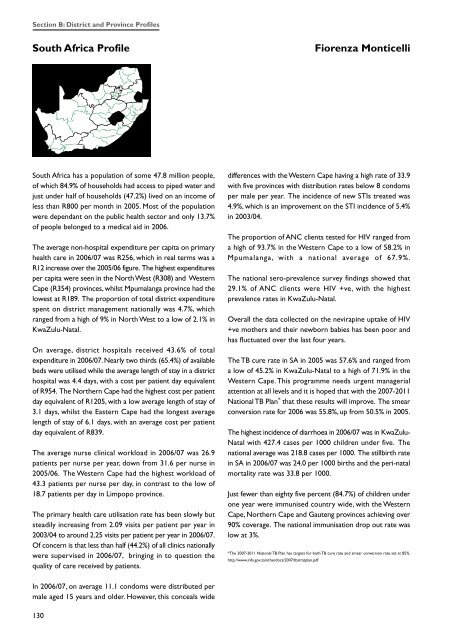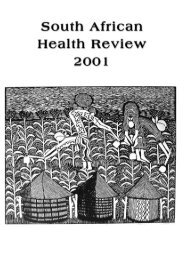DHB 2006/07 - Health Systems Trust
DHB 2006/07 - Health Systems Trust
DHB 2006/07 - Health Systems Trust
Create successful ePaper yourself
Turn your PDF publications into a flip-book with our unique Google optimized e-Paper software.
Section B: District and Province Profiles<br />
South Africa Profile<br />
Fiorenza Monticelli<br />
South Africa has a population of some 47.8 million people,<br />
of which 84.9% of households had access to piped water and<br />
just under half of households (47.2%) lived on an income of<br />
less than R800 per month in 2005. Most of the population<br />
were dependant on the public health sector and only 13.7%<br />
of people belonged to a medical aid in <strong>2006</strong>.<br />
The average non-hospital expenditure per capita on primary<br />
health care in <strong>2006</strong>/<strong>07</strong> was R256, which in real terms was a<br />
R12 increase over the 2005/06 figure. The highest expenditures<br />
per capita were seen in the North West (R308) and Western<br />
Cape (R354) provinces, whilst Mpumalanga province had the<br />
lowest at R189. The proportion of total district expenditure<br />
spent on district management nationally was 4.7%, which<br />
ranged from a high of 9% in North West to a low of 2.1% in<br />
KwaZulu-Natal.<br />
On average, district hospitals received 43.6% of total<br />
expenditure in <strong>2006</strong>/<strong>07</strong>. Nearly two thirds (65.4%) of available<br />
beds were utilised while the average length of stay in a district<br />
hospital was 4.4 days, with a cost per patient day equivalent<br />
of R954. The Northern Cape had the highest cost per patient<br />
day equivalent of R1205, with a low average length of stay of<br />
3.1 days, whilst the Eastern Cape had the longest average<br />
length of stay of 6.1 days, with an average cost per patient<br />
day equivalent of R839.<br />
The average nurse clinical workload in <strong>2006</strong>/<strong>07</strong> was 26.9<br />
patients per nurse per year, down from 31.6 per nurse in<br />
2005/06. The Western Cape had the highest workload of<br />
43.3 patients per nurse per day, in contrast to the low of<br />
18.7 patients per day in Limpopo province.<br />
The primary health care utilisation rate has been slowly but<br />
steadily increasing from 2.09 visits per patient per year in<br />
2003/04 to around 2.25 visits per patient per year in <strong>2006</strong>/<strong>07</strong>.<br />
Of concern is that less than half (44.2%) of all clinics nationally<br />
were supervised in <strong>2006</strong>/<strong>07</strong>, bringing in to question the<br />
quality of care received by patients.<br />
differences with the Western Cape having a high rate of 33.9<br />
with five provinces with distribution rates below 8 condoms<br />
per male per year. The incidence of new STIs treated was<br />
4.9%, which is an improvement on the STI incidence of 5.4%<br />
in 2003/04.<br />
The proportion of ANC clients tested for HIV ranged from<br />
a high of 93.7% in the Western Cape to a low of 58.2% in<br />
Mpumalanga, with a national average of 67.9%.<br />
The national sero-prevalence survey findings showed that<br />
29.1% of ANC clients were HIV +ve, with the highest<br />
prevalence rates in KwaZulu-Natal.<br />
Overall the data collected on the nevirapine uptake of HIV<br />
+ve mothers and their newborn babies has been poor and<br />
has fluctuated over the last four years.<br />
The TB cure rate in SA in 2005 was 57.6% and ranged from<br />
a low of 45.2% in KwaZulu-Natal to a high of 71.9% in the<br />
Western Cape. This programme needs urgent managerial<br />
attention at all levels and it is hoped that with the 20<strong>07</strong>-2011<br />
National TB Plan * that these results will improve. The smear<br />
conversion rate for <strong>2006</strong> was 55.8%, up from 50.5% in 2005.<br />
The highest incidence of diarrhoea in <strong>2006</strong>/<strong>07</strong> was in KwaZulu-<br />
Natal with 427.4 cases per 1000 children under five. The<br />
national average was 218.8 cases per 1000. The stillbirth rate<br />
in SA in <strong>2006</strong>/<strong>07</strong> was 24.0 per 1000 births and the peri-natal<br />
mortality rate was 33.8 per 1000.<br />
Just fewer than eighty five percent (84.7%) of children under<br />
one year were immunised country wide, with the Western<br />
Cape, Northern Cape and Gauteng provinces achieving over<br />
90% coverage. The national immunisation drop out rate was<br />
low at 3%.<br />
*The 20<strong>07</strong>-2011 National TB Plan has targets for both TB cure rate and smear conversion rate set at 85%.<br />
http://www.info.gov.za/otherdocs/20<strong>07</strong>/tbstratplan.pdf<br />
In <strong>2006</strong>/<strong>07</strong>, on average 11.1 condoms were distributed per<br />
male aged 15 years and older. However, this conceals wide<br />
130

















